Home / Aromatic, Non-Aromatic, or Antiaromatic? Some Practice Problems
Aromaticity
Aromatic, Non-Aromatic, or Antiaromatic? Some Practice Problems
Last updated: February 20th, 2025 |
Aromatic vs Antiaromatic vs Non Aromatic Practice Exercises
Our last post in this series on aromaticity went through the 4 conditions a molecule must fulfill in order to be aromatic.
- First, it must be cyclic
- Second, every atom around the ring must have an available p-orbital
- Third, the number of electrons in the pi system must be 2, 6, 10, 14, 18, or a higher number in the set that increases from 18 in increments of 4 (22, 26, 30…. etc). We usually abbreviate this as [4n+2] pi electrons.
- Fourth, the molecule must be flat.
In that post we tried to explain what each of those rules meant – so if any of these individual items seem unclear to you, it might be a good idea to go back to that post.
In this post,we’re going to apply these 4 rules with some practice examples.
Table of Contents
- A System For Determining If Molecules Are Aromatic: Build A Table
- Benzene
- The Benzene Anion
- The Cyclopentadiene Cation
- Pyrrole
- Pyrrole Conjugate Acid
- Pyridine
- Thiophene
- Cyclobutadiene
- Cyclobutene Di-Anion
- Naphthalene
- Pyrylium Ion
- Indole
- Azulene
- Summary: Aromaticity Practice Exercises
- Notes
- Quiz Yourself!
1. A System For Determining If Molecules Are Aromatic: Build A Table
Here’s my tip for those of you getting started on trying to answer the question “Is this aromatic?” . Make a table.
Tables are great for organizing information. They also serve as a built-in checklist.
For instance, here’s an image from a tutoring session I did with a student where we determined whether or not several molecules were aromatic:
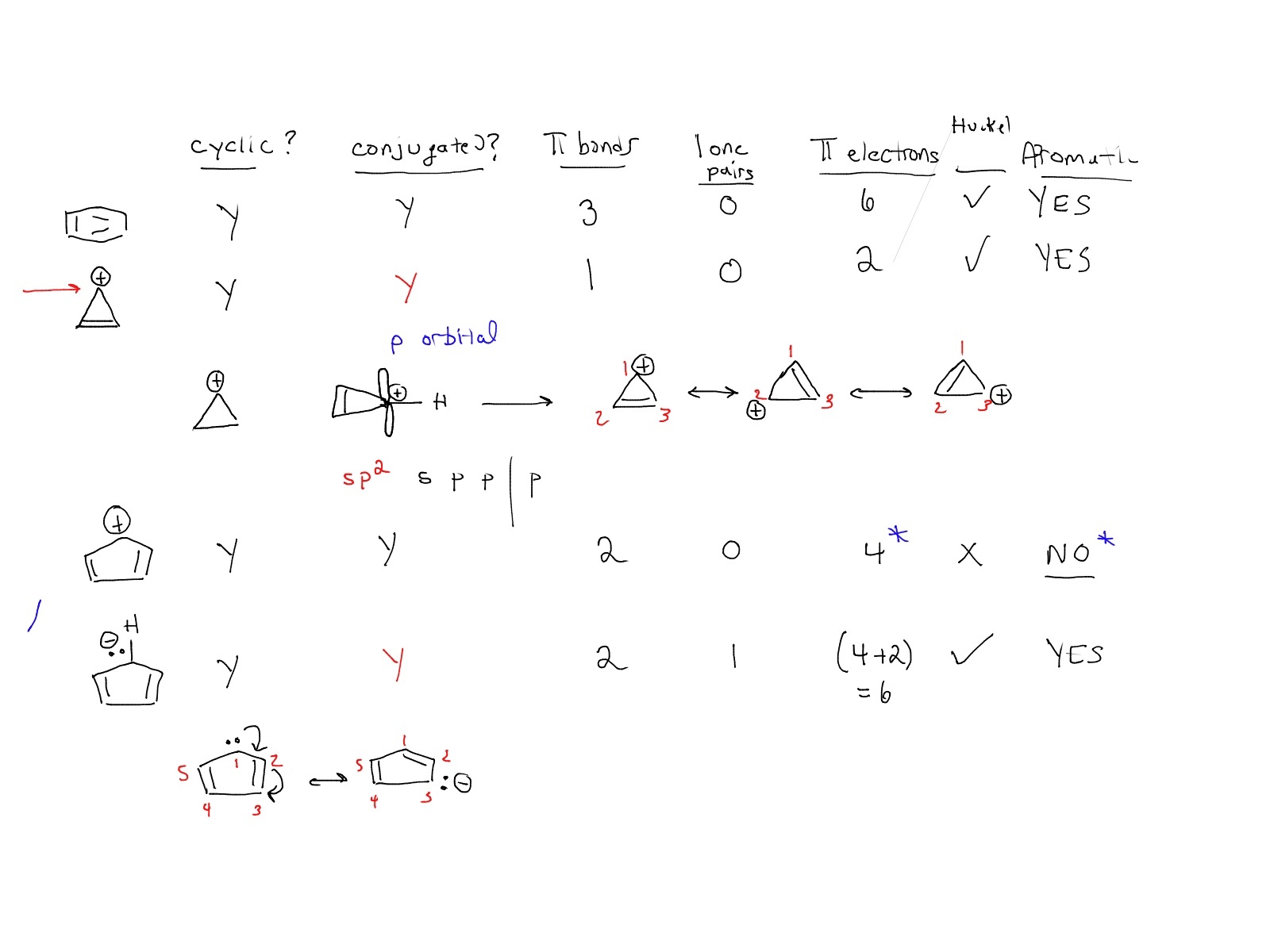
You’ll notice that my checklist doesn’t usually bother having a column for “flatness” because it’s generally assumed. (You need to know the few exceptions that come up – we covered that last time).
Today, we’re going to look at the following 13 molecules and try to determine if they are aromatic or not:
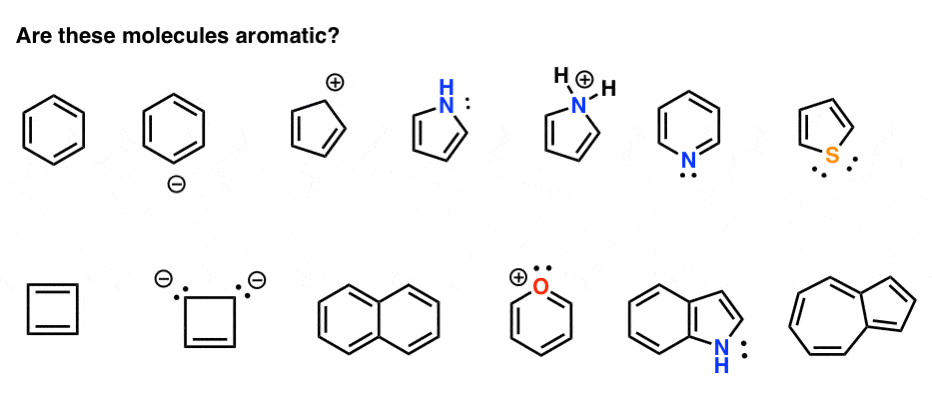
Let’s get started!
2. Benzene
The easiest example to start with is benzene, and it demonstrates how to use the table. It’s cyclic, conjugated, has 3 pi bonds and those pi bonds are all in the pi system. It has zero lone pairs that contribute to aromaticity. Therefore it has (3 × 2) + 0 = 6 pi electrons. We’re assuming it’s flat (it is). Checking off all the boxes, we can say that it’s aromatic.

3. The Benzene Anion
If you remove a proton from benzene, you get the benzene anion. Like benzene, it’s cyclic, conjugated, had 3 pi bonds and those pi bonds are all in the pi system. It’s tempting to look at that lone pair and to think that it might contribute to the pi system as well, giving 8 pi electrons total. However, that lone pair is in the plane of the molecule (along with the other C-H bonds) and thus can’t overlap with the p-orbitals. Therefore, for the purposes of determining aromaticity, we can ignore the lone pair.

4. The Cyclopentadiene Cation
The cyclopentadiene cation below is cyclic and conjugated (that positive charge represents a carbocation with an empty p-orbital). There are two pi bonds and zero lone pairs to contribute to the pi system. This gives us 4 total pi electrons, which is not a Hückel number. Therefore it isn’t aromatic.* [Note 1]

5. Pyrrole
Pyrrole is cyclic and conjugated (that lone pair on nitrogen can contribute to the pi-system). There are two pi bonds and one lone pair of electrons that contribute to the pi system. This gives us 6 total pi electrons, which is a Huckel number (i.e. satisfies 4n+2). Therefore it’s aromatic.

6. Pyrrole Conjugate Acid
If pyrrole is protonated on the nitrogen, the lone pair can no longer participate in the pi-system. Therefore the molecule drawn below is not aromatic.

7. Pyridine
Pyridine is cyclic, conjugated, and has three pi bonds. It’s a lot like the benzene anion in that the lone pair looks like it might contribute to the pi system, but in fact is in the plane of the ring (along with the C-H bonds) and thus cannot contribute (the nitrogen is already contributing a p-orbital towards the pi-system – note that it’s drawn as participating in a double bond with an adjacent carbon). Therefore we can ignore the lone pair for the purposes of aromaticity and there is a total of six pi electrons, which is a Huckel number and the molecule is aromatic.

8. Thiophene
Thiophene, the sulfur analog of furan, is cyclic and conjugated all the way around the ring. It has two pi bonds. What’s interesting about thiophene (and furan) is that although there is an atom bearing two lone pairs in the ring, we can only count one of those lone pairs toward the pi-system. [Each atom can contribute a maximum of one orbital and two electrons towards aromaticity]. The other lone pair is in the plane of the ring, much like the lone pair on the nitrogen of pyridine, above. Therefore thiophene has six pi electrons total, which is a Huckel number, and thiophene is aromatic.

9. Cyclobutadiene
Cyclobutadiene is cyclic and conjugated. There are two pi bonds and zero contributing lone pairs. Two pi bonds gives us a total of 4 pi electrons, which is not a Huckel number. Therefore it is not aromatic, just like the cyclopentadienyl cation, above. [Note 1]

10. Cyclobutene Di-Anion
Cyclobutadiene is not aromatic. If we somehow pump two electrons into cyclobutadiene, however, then the situation changes considerably. The cyclobutadiene dianion is cyclic and conjugated. It has a single pi bond, and now two carbons bearing lone pairs which can contribute to the pi system, giving us a total of six pi electrons. This is a Huckel number and thus the cyclobutadiene di-anion is aromatic!

11. Naphthalene
Naphthalene has two rings and is thus a bicyclic compound. It is conjugated around the perimeter of the rings and there are a total of 5 pi bonds and zero lone pairs, giving us 10 pi electrons total. 10 is a Huckel number (satisfying 4n+2 for n=2) and naphthalene is an aromatic molecule.

12. Pyrylium Ion
The pyrylium ion is a six-membered ring that, like benzene, has three pi bonds. It also bears a lone pair on the oxygen. Like pyridine and the benzene anion, this lone pair is actually in an orbital at right angles to the pi system so it does not in fact count towards aromaticity. Therefore the molecule has only 6 electrons in the pi system and is in fact aromatic.

13. Indole
Indole is a bicylic molecule that looks like a molecule of benzene fused to a molecule of pyrrole. It is conjugated; every atom around the perimeter of the two rings participates in the pi system. It has 4 pi bonds and a single pair of electrons on the nitrogen that participates in the pi system, giving 10 pi electrons in total. This is a Huckel number and indole is in fact aromatic.

14. Azulene
Azulene is another example of a bicyclic molecule, like naphthalene and indole, above. It’s conjugated all around the perimeter of the pi system. There are five total pi bonds and zero lone pair electrons, giving a total of 10 pi electrons, which is a Huckel number. And azulene is, in fact, aromatic.

If it’s hard to visualize azulene as aromatic, it might be helpful to draw a resonance form where both rings look like they have aromatic components. For example, in the resonance form below, you can think of azulene as being composed of the cycloheptatriene cation (aromatic) fused to the cyclopentadiene anion (also aromatic).
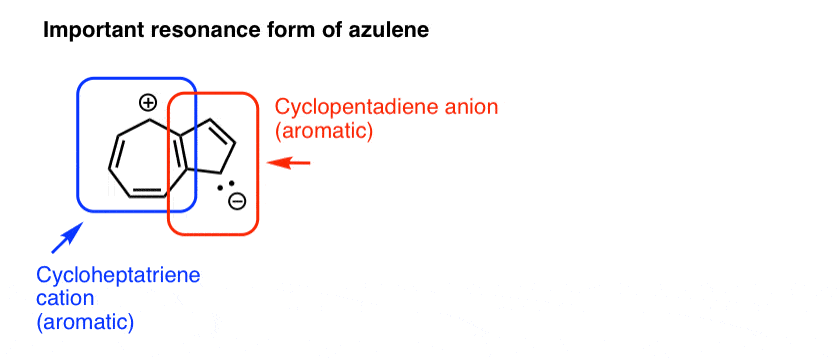
Note that one ring bears a negative charge and the other one bears a positive charge. It turns out that this resonance form has a significant contribution to the hybrid, since azulene itself has a substantial dipole moment (1.08 D). Naphthalene, in contrast, completely lacks a dipole moment.
15. Summary: Aromaticity Practice Exercises
The whole point of using a table like the one above is to organize your thoughts. Like a set of training wheels, if you do problems like this often enough, you’ll start to find that you don’t need it.
The most common part where students get tripped up is in counting the number of pi electrons. Just remember that each atom can at most contribute one p-orbital towards the pi system, and that the p-orbital can have (at most) two pi electrons.
Are there any other examples you’re not sure about that we should apply this system towards? Leave a comment!
Notes
Related Articles
Note 1. there are two molecules in particular in the list above which will deserve further discussion. The cyclopentadiene cation and cyclobutadiene were each described, above, as “not aromatic”, which is technically true.
Just as we saw that benzene is unusually stable compared to the theoretical “cyclohexatriene” , cyclobutadiene and the cyclopentadiene cation are interesting in that they are unusually unstable. This is a property called “antiaromaticity”, which we will describe in some detail in the next post.
Antiaromaticity and Antiaromatic Compounds
Thanks to Matt Struble for assistance with this post.
Quiz Yourself!

Become a MOC member to see the clickable quiz with answers on the back.

Become a MOC member to see the clickable quiz with answers on the back.

Become a MOC member to see the clickable quiz with answers on the back.
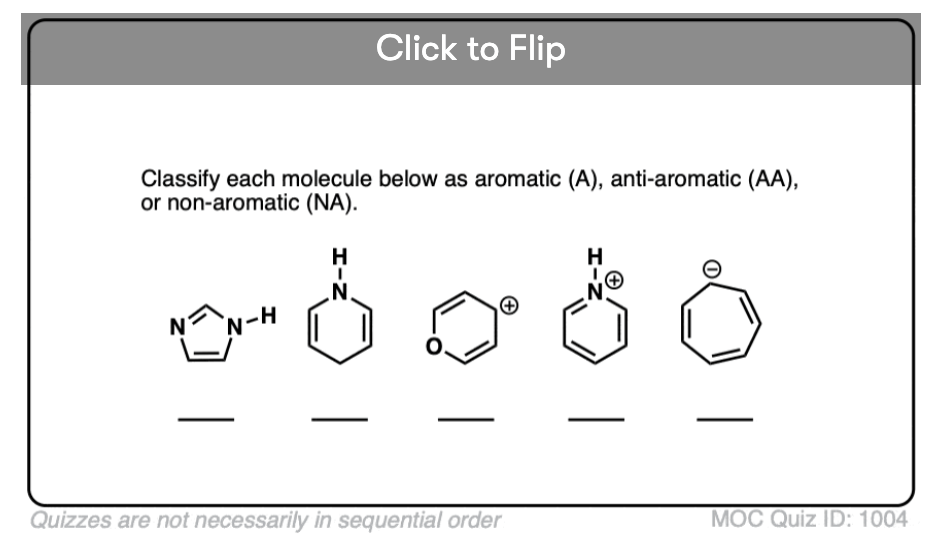
Become a MOC member to see the clickable quiz with answers on the back.
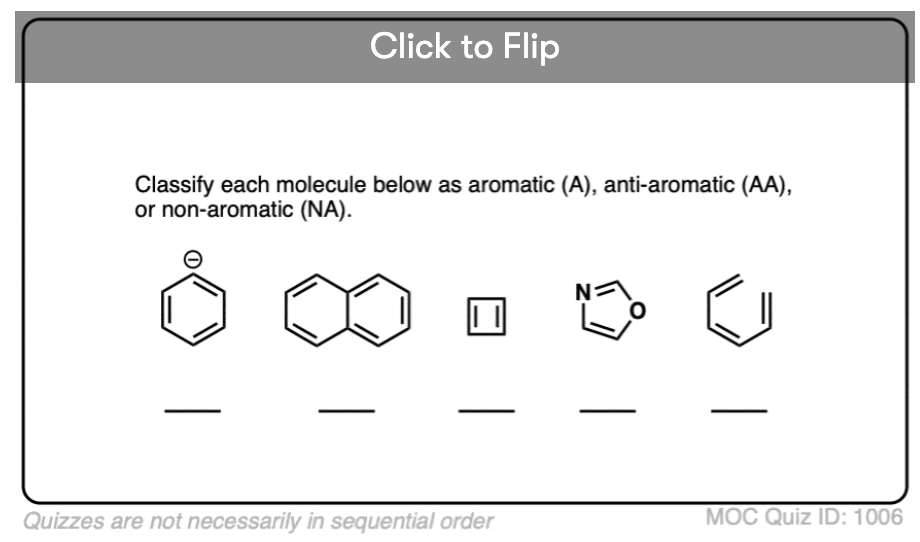
Become a MOC member to see the clickable quiz with answers on the back.
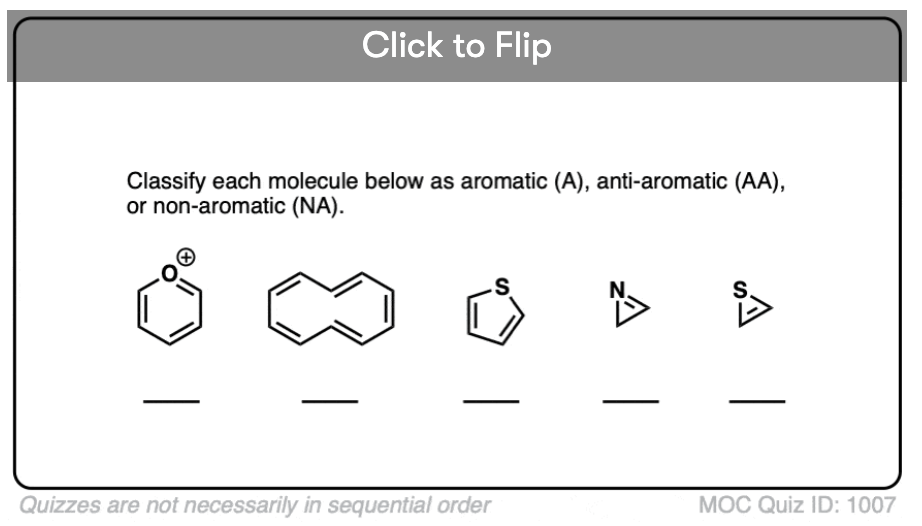
Become a MOC member to see the clickable quiz with answers on the back.
00 General Chemistry Review
01 Bonding, Structure, and Resonance
- How Do We Know Methane (CH4) Is Tetrahedral?
- Hybrid Orbitals and Hybridization
- How To Determine Hybridization: A Shortcut
- Orbital Hybridization And Bond Strengths
- Sigma bonds come in six varieties: Pi bonds come in one
- A Key Skill: How to Calculate Formal Charge
- The Four Intermolecular Forces and How They Affect Boiling Points
- 3 Trends That Affect Boiling Points
- How To Use Electronegativity To Determine Electron Density (and why NOT to trust formal charge)
- Introduction to Resonance
- How To Use Curved Arrows To Interchange Resonance Forms
- Evaluating Resonance Forms (1) - The Rule of Least Charges
- How To Find The Best Resonance Structure By Applying Electronegativity
- Evaluating Resonance Structures With Negative Charges
- Evaluating Resonance Structures With Positive Charge
- Exploring Resonance: Pi-Donation
- Exploring Resonance: Pi-acceptors
- In Summary: Evaluating Resonance Structures
- Drawing Resonance Structures: 3 Common Mistakes To Avoid
- How to apply electronegativity and resonance to understand reactivity
- Bond Hybridization Practice
- Structure and Bonding Practice Quizzes
- Resonance Structures Practice
02 Acid Base Reactions
- Introduction to Acid-Base Reactions
- Acid Base Reactions In Organic Chemistry
- The Stronger The Acid, The Weaker The Conjugate Base
- Walkthrough of Acid-Base Reactions (3) - Acidity Trends
- Five Key Factors That Influence Acidity
- Acid-Base Reactions: Introducing Ka and pKa
- How to Use a pKa Table
- The pKa Table Is Your Friend
- A Handy Rule of Thumb for Acid-Base Reactions
- Acid Base Reactions Are Fast
- pKa Values Span 60 Orders Of Magnitude
- How Protonation and Deprotonation Affect Reactivity
- Acid Base Practice Problems
03 Alkanes and Nomenclature
- Meet the (Most Important) Functional Groups
- Condensed Formulas: Deciphering What the Brackets Mean
- Hidden Hydrogens, Hidden Lone Pairs, Hidden Counterions
- Don't Be Futyl, Learn The Butyls
- Primary, Secondary, Tertiary, Quaternary In Organic Chemistry
- Branching, and Its Affect On Melting and Boiling Points
- The Many, Many Ways of Drawing Butane
- Wedge And Dash Convention For Tetrahedral Carbon
- Common Mistakes in Organic Chemistry: Pentavalent Carbon
- Table of Functional Group Priorities for Nomenclature
- Summary Sheet - Alkane Nomenclature
- Organic Chemistry IUPAC Nomenclature Demystified With A Simple Puzzle Piece Approach
- Boiling Point Quizzes
- Organic Chemistry Nomenclature Quizzes
04 Conformations and Cycloalkanes
- Staggered vs Eclipsed Conformations of Ethane
- Conformational Isomers of Propane
- Newman Projection of Butane (and Gauche Conformation)
- Introduction to Cycloalkanes
- Geometric Isomers In Small Rings: Cis And Trans Cycloalkanes
- Calculation of Ring Strain In Cycloalkanes
- Cycloalkanes - Ring Strain In Cyclopropane And Cyclobutane
- Cyclohexane Conformations
- Cyclohexane Chair Conformation: An Aerial Tour
- How To Draw The Cyclohexane Chair Conformation
- The Cyclohexane Chair Flip
- The Cyclohexane Chair Flip - Energy Diagram
- Substituted Cyclohexanes - Axial vs Equatorial
- Ranking The Bulkiness Of Substituents On Cyclohexanes: "A-Values"
- Cyclohexane Chair Conformation Stability: Which One Is Lower Energy?
- Fused Rings - Cis-Decalin and Trans-Decalin
- Naming Bicyclic Compounds - Fused, Bridged, and Spiro
- Bredt's Rule (And Summary of Cycloalkanes)
- Newman Projection Practice
- Cycloalkanes Practice Problems
05 A Primer On Organic Reactions
- The Most Important Question To Ask When Learning a New Reaction
- Curved Arrows (for reactions)
- Nucleophiles and Electrophiles
- The Three Classes of Nucleophiles
- Nucleophilicity vs. Basicity
- What Makes A Good Nucleophile?
- What Makes A Good Leaving Group?
- 3 Factors That Stabilize Carbocations
- Equilibrium and Energy Relationships
- 7 Factors that stabilize negative charge in organic chemistry
- 7 Factors That Stabilize Positive Charge in Organic Chemistry
- What's a Transition State?
- Hammond's Postulate
- Learning Organic Chemistry Reactions: A Checklist (PDF)
- Introduction to Oxidative Cleavage Reactions
06 Free Radical Reactions
- Bond Dissociation Energies = Homolytic Cleavage
- Free Radical Reactions
- 3 Factors That Stabilize Free Radicals
- What Factors Destabilize Free Radicals?
- Bond Strengths And Radical Stability
- Free Radical Initiation: Why Is "Light" Or "Heat" Required?
- Initiation, Propagation, Termination
- Monochlorination Products Of Propane, Pentane, And Other Alkanes
- Selectivity In Free Radical Reactions
- Selectivity in Free Radical Reactions: Bromination vs. Chlorination
- Halogenation At Tiffany's
- Allylic Bromination
- Bonus Topic: Allylic Rearrangements
- In Summary: Free Radicals
- Synthesis (2) - Reactions of Alkanes
- Free Radicals Practice Quizzes
07 Stereochemistry and Chirality
- Types of Isomers: Constitutional Isomers, Stereoisomers, Enantiomers, and Diastereomers
- How To Draw The Enantiomer Of A Chiral Molecule
- How To Draw A Bond Rotation
- Introduction to Assigning (R) and (S): The Cahn-Ingold-Prelog Rules
- Assigning Cahn-Ingold-Prelog (CIP) Priorities (2) - The Method of Dots
- Enantiomers vs Diastereomers vs The Same? Two Methods For Solving Problems
- Assigning R/S To Newman Projections (And Converting Newman To Line Diagrams)
- How To Determine R and S Configurations On A Fischer Projection
- The Meso Trap
- Optical Rotation, Optical Activity, and Specific Rotation
- Optical Purity and Enantiomeric Excess
- What's a Racemic Mixture?
- Chiral Allenes And Chiral Axes
- Stereochemistry Practice Problems and Quizzes
08 Substitution Reactions
- Nucleophilic Substitution Reactions - Introduction
- Two Types of Nucleophilic Substitution Reactions
- The SN2 Mechanism
- Why the SN2 Reaction Is Powerful
- The SN1 Mechanism
- The Conjugate Acid Is A Better Leaving Group
- Comparing the SN1 and SN2 Reactions
- Polar Protic? Polar Aprotic? Nonpolar? All About Solvents
- Steric Hindrance is Like a Fat Goalie
- Common Blind Spot: Intramolecular Reactions
- Substitution Practice - SN1
- Substitution Practice - SN2
09 Elimination Reactions
- Elimination Reactions (1): Introduction And The Key Pattern
- Elimination Reactions (2): The Zaitsev Rule
- Elimination Reactions Are Favored By Heat
- Two Elimination Reaction Patterns
- The E1 Reaction
- The E2 Mechanism
- E1 vs E2: Comparing the E1 and E2 Reactions
- Antiperiplanar Relationships: The E2 Reaction and Cyclohexane Rings
- Bulky Bases in Elimination Reactions
- Comparing the E1 vs SN1 Reactions
- Elimination (E1) Reactions With Rearrangements
- E1cB - Elimination (Unimolecular) Conjugate Base
- Elimination (E1) Practice Problems And Solutions
- Elimination (E2) Practice Problems and Solutions
10 Rearrangements
11 SN1/SN2/E1/E2 Decision
- Identifying Where Substitution and Elimination Reactions Happen
- Deciding SN1/SN2/E1/E2 (1) - The Substrate
- Deciding SN1/SN2/E1/E2 (2) - The Nucleophile/Base
- SN1 vs E1 and SN2 vs E2 : The Temperature
- Deciding SN1/SN2/E1/E2 - The Solvent
- Wrapup: The Key Factors For Determining SN1/SN2/E1/E2
- Alkyl Halide Reaction Map And Summary
- SN1 SN2 E1 E2 Practice Problems
12 Alkene Reactions
- E and Z Notation For Alkenes (+ Cis/Trans)
- Alkene Stability
- Alkene Addition Reactions: "Regioselectivity" and "Stereoselectivity" (Syn/Anti)
- Stereoselective and Stereospecific Reactions
- Hydrohalogenation of Alkenes and Markovnikov's Rule
- Hydration of Alkenes With Aqueous Acid
- Rearrangements in Alkene Addition Reactions
- Halogenation of Alkenes and Halohydrin Formation
- Oxymercuration Demercuration of Alkenes
- Hydroboration Oxidation of Alkenes
- m-CPBA (meta-chloroperoxybenzoic acid)
- OsO4 (Osmium Tetroxide) for Dihydroxylation of Alkenes
- Palladium on Carbon (Pd/C) for Catalytic Hydrogenation of Alkenes
- Cyclopropanation of Alkenes
- A Fourth Alkene Addition Pattern - Free Radical Addition
- Alkene Reactions: Ozonolysis
- Summary: Three Key Families Of Alkene Reaction Mechanisms
- Synthesis (4) - Alkene Reaction Map, Including Alkyl Halide Reactions
- Alkene Reactions Practice Problems
13 Alkyne Reactions
- Acetylides from Alkynes, And Substitution Reactions of Acetylides
- Partial Reduction of Alkynes With Lindlar's Catalyst
- Partial Reduction of Alkynes With Na/NH3 To Obtain Trans Alkenes
- Alkyne Hydroboration With "R2BH"
- Hydration and Oxymercuration of Alkynes
- Hydrohalogenation of Alkynes
- Alkyne Halogenation: Bromination and Chlorination of Alkynes
- Alkyne Reactions - The "Concerted" Pathway
- Alkenes To Alkynes Via Halogenation And Elimination Reactions
- Alkynes Are A Blank Canvas
- Synthesis (5) - Reactions of Alkynes
- Alkyne Reactions Practice Problems With Answers
14 Alcohols, Epoxides and Ethers
- Alcohols - Nomenclature and Properties
- Alcohols Can Act As Acids Or Bases (And Why It Matters)
- Alcohols - Acidity and Basicity
- The Williamson Ether Synthesis
- Ethers From Alkenes, Tertiary Alkyl Halides and Alkoxymercuration
- Alcohols To Ethers via Acid Catalysis
- Cleavage Of Ethers With Acid
- Epoxides - The Outlier Of The Ether Family
- Opening of Epoxides With Acid
- Epoxide Ring Opening With Base
- Making Alkyl Halides From Alcohols
- Tosylates And Mesylates
- PBr3 and SOCl2
- Elimination Reactions of Alcohols
- Elimination of Alcohols To Alkenes With POCl3
- Alcohol Oxidation: "Strong" and "Weak" Oxidants
- Demystifying The Mechanisms of Alcohol Oxidations
- Protecting Groups For Alcohols
- Thiols And Thioethers
- Calculating the oxidation state of a carbon
- Oxidation and Reduction in Organic Chemistry
- Oxidation Ladders
- SOCl2 Mechanism For Alcohols To Alkyl Halides: SN2 versus SNi
- Alcohol Reactions Roadmap (PDF)
- Alcohol Reaction Practice Problems
- Epoxide Reaction Quizzes
- Oxidation and Reduction Practice Quizzes
15 Organometallics
- What's An Organometallic?
- Formation of Grignard and Organolithium Reagents
- Organometallics Are Strong Bases
- Reactions of Grignard Reagents
- Protecting Groups In Grignard Reactions
- Synthesis Problems Involving Grignard Reagents
- Grignard Reactions And Synthesis (2)
- Organocuprates (Gilman Reagents): How They're Made
- Gilman Reagents (Organocuprates): What They're Used For
- The Heck, Suzuki, and Olefin Metathesis Reactions (And Why They Don't Belong In Most Introductory Organic Chemistry Courses)
- Reaction Map: Reactions of Organometallics
- Grignard Practice Problems
16 Spectroscopy
- Degrees of Unsaturation (or IHD, Index of Hydrogen Deficiency)
- Conjugation And Color (+ How Bleach Works)
- Introduction To UV-Vis Spectroscopy
- UV-Vis Spectroscopy: Absorbance of Carbonyls
- UV-Vis Spectroscopy: Practice Questions
- Bond Vibrations, Infrared Spectroscopy, and the "Ball and Spring" Model
- Infrared Spectroscopy: A Quick Primer On Interpreting Spectra
- IR Spectroscopy: 4 Practice Problems
- 1H NMR: How Many Signals?
- Homotopic, Enantiotopic, Diastereotopic
- Diastereotopic Protons in 1H NMR Spectroscopy: Examples
- 13-C NMR - How Many Signals
- Liquid Gold: Pheromones In Doe Urine
- Natural Product Isolation (1) - Extraction
- Natural Product Isolation (2) - Purification Techniques, An Overview
- Structure Determination Case Study: Deer Tarsal Gland Pheromone
17 Dienes and MO Theory
- What To Expect In Organic Chemistry 2
- Are these molecules conjugated?
- Conjugation And Resonance In Organic Chemistry
- Bonding And Antibonding Pi Orbitals
- Molecular Orbitals of The Allyl Cation, Allyl Radical, and Allyl Anion
- Pi Molecular Orbitals of Butadiene
- Reactions of Dienes: 1,2 and 1,4 Addition
- Thermodynamic and Kinetic Products
- More On 1,2 and 1,4 Additions To Dienes
- s-cis and s-trans
- The Diels-Alder Reaction
- Cyclic Dienes and Dienophiles in the Diels-Alder Reaction
- Stereochemistry of the Diels-Alder Reaction
- Exo vs Endo Products In The Diels Alder: How To Tell Them Apart
- HOMO and LUMO In the Diels Alder Reaction
- Why Are Endo vs Exo Products Favored in the Diels-Alder Reaction?
- Diels-Alder Reaction: Kinetic and Thermodynamic Control
- The Retro Diels-Alder Reaction
- The Intramolecular Diels Alder Reaction
- Regiochemistry In The Diels-Alder Reaction
- The Cope and Claisen Rearrangements
- Electrocyclic Reactions
- Electrocyclic Ring Opening And Closure (2) - Six (or Eight) Pi Electrons
- Diels Alder Practice Problems
- Molecular Orbital Theory Practice
18 Aromaticity
- Introduction To Aromaticity
- Rules For Aromaticity
- Huckel's Rule: What Does 4n+2 Mean?
- Aromatic, Non-Aromatic, or Antiaromatic? Some Practice Problems
- Antiaromatic Compounds and Antiaromaticity
- The Pi Molecular Orbitals of Benzene
- The Pi Molecular Orbitals of Cyclobutadiene
- Frost Circles
- Aromaticity Practice Quizzes
19 Reactions of Aromatic Molecules
- Electrophilic Aromatic Substitution: Introduction
- Activating and Deactivating Groups In Electrophilic Aromatic Substitution
- Electrophilic Aromatic Substitution - The Mechanism
- Ortho-, Para- and Meta- Directors in Electrophilic Aromatic Substitution
- Understanding Ortho, Para, and Meta Directors
- Why are halogens ortho- para- directors?
- Disubstituted Benzenes: The Strongest Electron-Donor "Wins"
- Electrophilic Aromatic Substitutions (1) - Halogenation of Benzene
- Electrophilic Aromatic Substitutions (2) - Nitration and Sulfonation
- EAS Reactions (3) - Friedel-Crafts Acylation and Friedel-Crafts Alkylation
- Intramolecular Friedel-Crafts Reactions
- Nucleophilic Aromatic Substitution (NAS)
- Nucleophilic Aromatic Substitution (2) - The Benzyne Mechanism
- Reactions on the "Benzylic" Carbon: Bromination And Oxidation
- The Wolff-Kishner, Clemmensen, And Other Carbonyl Reductions
- More Reactions on the Aromatic Sidechain: Reduction of Nitro Groups and the Baeyer Villiger
- Aromatic Synthesis (1) - "Order Of Operations"
- Synthesis of Benzene Derivatives (2) - Polarity Reversal
- Aromatic Synthesis (3) - Sulfonyl Blocking Groups
- Birch Reduction
- Synthesis (7): Reaction Map of Benzene and Related Aromatic Compounds
- Aromatic Reactions and Synthesis Practice
- Electrophilic Aromatic Substitution Practice Problems
20 Aldehydes and Ketones
- What's The Alpha Carbon In Carbonyl Compounds?
- Nucleophilic Addition To Carbonyls
- Aldehydes and Ketones: 14 Reactions With The Same Mechanism
- Sodium Borohydride (NaBH4) Reduction of Aldehydes and Ketones
- Grignard Reagents For Addition To Aldehydes and Ketones
- Wittig Reaction
- Hydrates, Hemiacetals, and Acetals
- Imines - Properties, Formation, Reactions, and Mechanisms
- All About Enamines
- Breaking Down Carbonyl Reaction Mechanisms: Reactions of Anionic Nucleophiles (Part 2)
- Aldehydes Ketones Reaction Practice
21 Carboxylic Acid Derivatives
- Nucleophilic Acyl Substitution (With Negatively Charged Nucleophiles)
- Addition-Elimination Mechanisms With Neutral Nucleophiles (Including Acid Catalysis)
- Basic Hydrolysis of Esters - Saponification
- Transesterification
- Proton Transfer
- Fischer Esterification - Carboxylic Acid to Ester Under Acidic Conditions
- Lithium Aluminum Hydride (LiAlH4) For Reduction of Carboxylic Acid Derivatives
- LiAlH[Ot-Bu]3 For The Reduction of Acid Halides To Aldehydes
- Di-isobutyl Aluminum Hydride (DIBAL) For The Partial Reduction of Esters and Nitriles
- Amide Hydrolysis
- Thionyl Chloride (SOCl2) And Conversion of Carboxylic Acids to Acid Halides
- Diazomethane (CH2N2)
- Carbonyl Chemistry: Learn Six Mechanisms For the Price Of One
- Making Music With Mechanisms (PADPED)
- Carboxylic Acid Derivatives Practice Questions
22 Enols and Enolates
- Keto-Enol Tautomerism
- Enolates - Formation, Stability, and Simple Reactions
- Kinetic Versus Thermodynamic Enolates
- Aldol Addition and Condensation Reactions
- Reactions of Enols - Acid-Catalyzed Aldol, Halogenation, and Mannich Reactions
- Claisen Condensation and Dieckmann Condensation
- Decarboxylation
- The Malonic Ester and Acetoacetic Ester Synthesis
- The Michael Addition Reaction and Conjugate Addition
- The Robinson Annulation
- Haloform Reaction
- The Hell–Volhard–Zelinsky Reaction
- Enols and Enolates Practice Quizzes
23 Amines
- The Amide Functional Group: Properties, Synthesis, and Nomenclature
- Basicity of Amines And pKaH
- 5 Key Basicity Trends of Amines
- The Mesomeric Effect And Aromatic Amines
- Nucleophilicity of Amines
- Alkylation of Amines (Sucks!)
- Reductive Amination
- The Gabriel Synthesis
- Some Reactions of Azides
- The Hofmann Elimination
- The Hofmann and Curtius Rearrangements
- The Cope Elimination
- Protecting Groups for Amines - Carbamates
- The Strecker Synthesis of Amino Acids
- Introduction to Peptide Synthesis
- Reactions of Diazonium Salts: Sandmeyer and Related Reactions
- Amine Practice Questions
24 Carbohydrates
- D and L Notation For Sugars
- Pyranoses and Furanoses: Ring-Chain Tautomerism In Sugars
- What is Mutarotation?
- Reducing Sugars
- The Big Damn Post Of Carbohydrate-Related Chemistry Definitions
- The Haworth Projection
- Converting a Fischer Projection To A Haworth (And Vice Versa)
- Reactions of Sugars: Glycosylation and Protection
- The Ruff Degradation and Kiliani-Fischer Synthesis
- Isoelectric Points of Amino Acids (and How To Calculate Them)
- Carbohydrates Practice
- Amino Acid Quizzes
25 Fun and Miscellaneous
- A Gallery of Some Interesting Molecules From Nature
- Screw Organic Chemistry, I'm Just Going To Write About Cats
- On Cats, Part 1: Conformations and Configurations
- On Cats, Part 2: Cat Line Diagrams
- On Cats, Part 4: Enantiocats
- On Cats, Part 6: Stereocenters
- Organic Chemistry Is Shit
- The Organic Chemistry Behind "The Pill"
- Maybe they should call them, "Formal Wins" ?
- Why Do Organic Chemists Use Kilocalories?
- The Principle of Least Effort
- Organic Chemistry GIFS - Resonance Forms
- Reproducibility In Organic Chemistry
- What Holds The Nucleus Together?
- How Reactions Are Like Music
- Organic Chemistry and the New MCAT
26 Organic Chemistry Tips and Tricks
- Common Mistakes: Formal Charges Can Mislead
- Partial Charges Give Clues About Electron Flow
- Draw The Ugly Version First
- Organic Chemistry Study Tips: Learn the Trends
- The 8 Types of Arrows In Organic Chemistry, Explained
- Top 10 Skills To Master Before An Organic Chemistry 2 Final
- Common Mistakes with Carbonyls: Carboxylic Acids... Are Acids!
- Planning Organic Synthesis With "Reaction Maps"
- Alkene Addition Pattern #1: The "Carbocation Pathway"
- Alkene Addition Pattern #2: The "Three-Membered Ring" Pathway
- Alkene Addition Pattern #3: The "Concerted" Pathway
- Number Your Carbons!
- The 4 Major Classes of Reactions in Org 1
- How (and why) electrons flow
- Grossman's Rule
- Three Exam Tips
- A 3-Step Method For Thinking Through Synthesis Problems
- Putting It Together
- Putting Diels-Alder Products in Perspective
- The Ups and Downs of Cyclohexanes
- The Most Annoying Exceptions in Org 1 (Part 1)
- The Most Annoying Exceptions in Org 1 (Part 2)
- The Marriage May Be Bad, But the Divorce Still Costs Money
- 9 Nomenclature Conventions To Know
- Nucleophile attacks Electrophile
27 Case Studies of Successful O-Chem Students
- Success Stories: How Corina Got The The "Hard" Professor - And Got An A+ Anyway
- How Helena Aced Organic Chemistry
- From a "Drop" To B+ in Org 2 – How A Hard Working Student Turned It Around
- How Serge Aced Organic Chemistry
- Success Stories: How Zach Aced Organic Chemistry 1
- Success Stories: How Kari Went From C– to B+
- How Esther Bounced Back From a "C" To Get A's In Organic Chemistry 1 And 2
- How Tyrell Got The Highest Grade In Her Organic Chemistry Course
- This Is Why Students Use Flashcards
- Success Stories: How Stu Aced Organic Chemistry
- How John Pulled Up His Organic Chemistry Exam Grades
- Success Stories: How Nathan Aced Organic Chemistry (Without It Taking Over His Life)
- How Chris Aced Org 1 and Org 2
- Interview: How Jay Got an A+ In Organic Chemistry
- How to Do Well in Organic Chemistry: One Student's Advice
- "America's Top TA" Shares His Secrets For Teaching O-Chem
- "Organic Chemistry Is Like..." - A Few Metaphors
- How To Do Well In Organic Chemistry: Advice From A Tutor
- Guest post: "I went from being afraid of tests to actually looking forward to them".
What’s the difference between non-aromatic and anti-aromatic?
what do you mean conjugated? how to identifies the molecules are conjugate?
“Are these molecules conjugated?” https://www.masterorganicchemistry.com/2011/03/08/are-these-alkenes-conjugated/
THANK YOU!!!! so helpful!!!!
I found a source saying cyclobutan-1,2,3-trione is aromatic .Is it correct? If yes please explain how?
What will be the aromaticity of a compound having both an aromatic and an antiaromatic ring? Eg- phenyl cyclobutadiene
The molecule does not exist.
However if you look at azulene, it’s possible to push the arrows such that you get a cyclopentadienyl cation and a heptatrienyl anion, each of which are (in theory) anti aromatic. However based on the dipole moment the contribution of this resonance form is zero
Hey James,
why is ”Pyrrole Conjugate Acid” not Aromatic? I assume, it has an empty p-orbital. And with this empty p-orbital, it is possible to build a conjugated phi orbital system with the rest existing phi-bonds.
Thanks in advance!
It’s not conjugated all the way around the ring. If you look at the nitrogen you’ll see that it is sp3 hybridized (attached to four sigma bonds). If it had an empty p orbital that would give it 5 orbitals which violates the octet rule!
Is toluene aromatic because its ring meets the rules, or does the methyl substituent not being planar make it non-aromatic?
Because the ring meets the rules. : – )
The methyl group has no impact on the aromaticity. Aromaticity is determined by the pi-electrons (i.e. the electrons in the double bonds).
I can’t understand what is aromatic and also not give any example in simple way
cycloheptatrienyl anion…non-aromatic or antiaromatic?
Count the pi electrons and that should tell you!
cyclic C3H3 Free radical->Aromatic or non-Aromatic?
Odd number of pi electrons –> not aromatic
I am wondering about compounds that contain an aromatic system. Would the entire molecule be aromatic? Eg benzaldehyde
Just the benzene ring. The aldehyde is not considered part of the aromatic system.
How do we determine aromaticity of bicyclo compounds high , one ring is aromatic (benzene ) and the other ring is a non planar cyclohexene ring ?
Is the conjugate base of Pyrrole aromatic? It does seem to have 6 pi electrons but I read somewhere that the Pyrrole anion is unstable?
Yes it is. The N-H bond is in the plane of the ring along with the C-H bonds, and the lone pair liberated by deprotonating nitrogen does not affect aromaticity since it is at right angles to the pi system.
Hey James, for the Pyrrole conj. acid example, I was wondering how that isn’t conjugated. the reason why there is a positive charge to nitrogen is that it has 4 electrons when it needs 5 for the valence (formal charge)? My question is wouldn’t that positive charge be delocalized by moving a double bond adjacent to it, hence being conjugated??
There is no way that the formal charge on nitrogen can be removed through pushing the other double bonds around, since the nitrogen has no available p orbitals that can be conjugated with the pi-system. Nitrogen in this case has all 8 of its electrons bound up in single bonds, and we know that resonance forms never involve breaking single bonds, right?
Cyclohexenyl dianion. … whether it is aromatic or not??? The two anions are in 1St and 4th carbon.. double bond is between 2nd and 3rd carbon….
Are any of the carbons in the ring sp3 hybridized? If so, then it’s not aromatic….
Hi James, from down under in Oz. Thank you very much for your clear and concise explanations. My memory is not good, so understanding the mechanisms and the logic behind the chemistry really helps and saves taxing the memory.
I used your table above to answer questions like this and it was very helpful. However, one problem that I can’t find that they gave us was using thiophene C4H4S which you have in your example above which is aromatic. However, the question asked for the thiophene radical C4HS+ if that was aromatic? My thoughts were probably not because it would destabilize the aromaticity and even though it is five electrons close to Huckel’s number it is not a Huckel number.
Thanks,
Peter
Hi Peter – The thiophene radical will not be aromatic. It will be a radical cation. Thiophene has six pi electrons. Remove an electron from this and you have five electrons.
The same is true for the benzene radical (not to be confused with the phenyl or benzyl radical!)
Hope this helps! James
Regarding naphthalene, I was confused as to why it’s considered an aromatic compound? Isn’t there strain due to the repulsion of hydrogen atoms on the shared carbon atoms, thus rendering the molecule not flat? I understand that if a bridge was present, it makes the molecular compound flat again, thus fulfilling a criteria of aromaticity. Sorry, just a bit confused.
There aren’t hydrogen atoms on the shared carbon atoms in naphthalene – if you count the bonds, each carbon has 4.
I have probably appreciated you before as well. I love you so much Sir James. You make organic chemistry so so so so so much easy. I thoroughly enjoy your lessons. God bless you more and more. Love, from Mumbai, India.
Thank you Samina – glad you find it helpful!
Sooooo helpful and clear. Thanks a million!
Thanks Jezebel!
Cyclobutadiene dianion has 6 pi electrons. However, there is no conjugation covering ALL the atoms. Is this not a violation of Huckel rule?
Sure there is. All four carbons are conjugated through their p orbitals. Two of them are half-filled, and two of them are completely full.
Loved this one. Helped a lot in understanding aromaticity. Still having problems in multiple ring questions what if one ring is aromatic and the other is antiaromatic?
The old enough paper
Aromatic molecular zones and fragments, L. Tarko, ARKIVOC, 2008, Part xi, p. 24 – 45
offers a very different answer for title question.
Above #1, #3 and #4 conditions, actually based on Huckel model, are long time ago obsolete.
That’s interesting. Thank you Tarko.
In furan,are the the two C-O bonds at right angles because they are covalent bond formed involving py and pz orbitals of oxygen.
Also does the one lone pair of oxygen which is counted in pi electrons shows resonance because it is in px orbital which is perpendicular to py and pz and the molecular plane,while the other lone pair in s orbital does not involve in resonance because it lies in the molecular plane?
Just a typo- “fused to the cyclopentadiene cation” kindly change it to anion!
Otherwise very helpful post!!!
Fixed. Thanks for telling me!